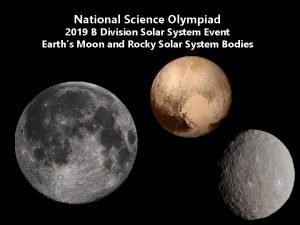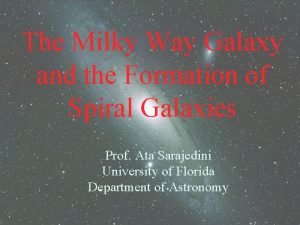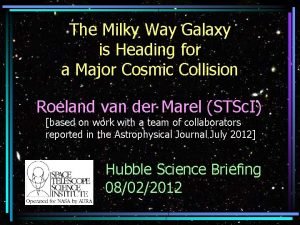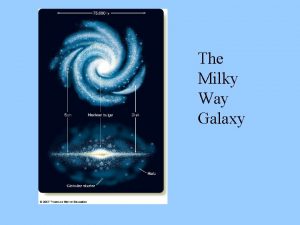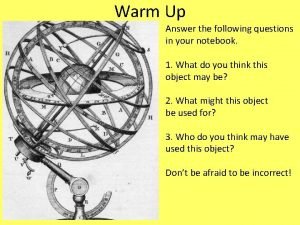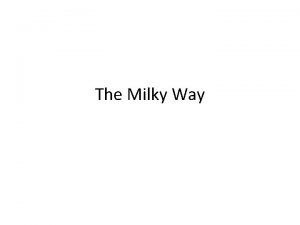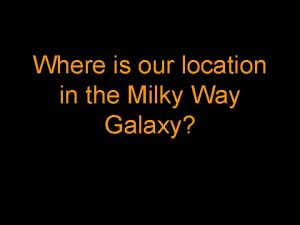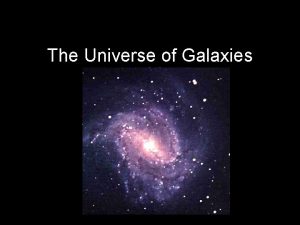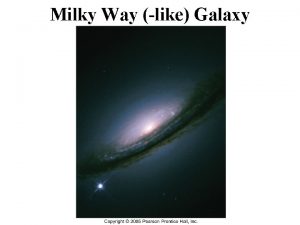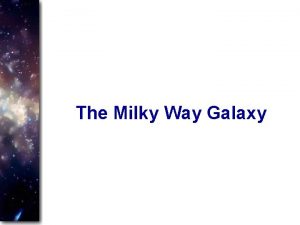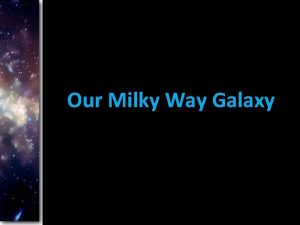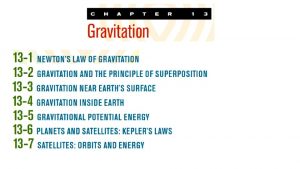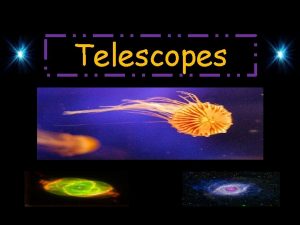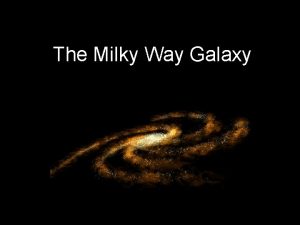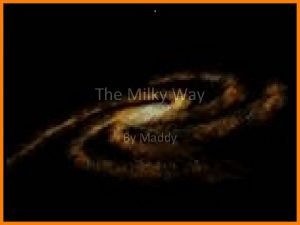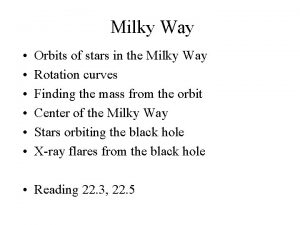The Milky Way Galaxy Introduction l l The











- Slides: 11

The Milky Way Galaxy

Introduction l l The pale band of light spangled with stars stretching across the sky is the Milky Way, a swath of light named by the ancient Greeks In the 17 th century, Galileo showed that the Milky Way is millions of stars too dim to see individually Today we know the Milky Way is a slow revolving disk of stars, a galaxy We also know today that the Milky Way is filled with stars of various sizes, many of them found in clusters, and clouds of gas and dust The Milky Way Galaxy 2

Overview of the Milky Way l Structure and Contents l The Milky Way consists of three parts l Disk Spiral arms distribution of stars, gas, and dust with a diameter of about 100, 000 light-years l Rotation with all objects circling in the same direction l High density of stars near center to low density farther out l Dust and gas is nearly 15% of the disc’s mass l Most of galaxy is hidden from Earth due to dust, including the central nucleus with its dense swarm of stars and gas in which a massive black hole may reside l Radio and infrared telescopes can “see” entire galaxy l The Milky Way Galaxy 3

Overview of the Milky Way l Structure and Contents (continued) l The Milky Way consists of three parts (continued) l Halo Roughly spherical region l Contains mainly old stars, such as globular clusters l Large amounts of dark matter may also be present l l Bulge Flattened collection of stars surrounding dense core of galaxy l About 1/3 the diameter of the galaxy l The Milky Way Galaxy 4

Overview of the Milky Way l Mass of the Milky Way and the Number of Stars l l l Assuming that the average star has a mass similar to that of the Sun, then based on the Milky Way’s mass, there are roughly 100 billion stars From large difference between this mass and what is observed, astronomers conclude Milky Way is embedded in vast halo of material that emits no radiation (at any wavelength) – dark matter Age of the Milky Way l l More recent model calculations and observations suggests the old star ages are about 11 -13 billion years A rough estimate of the Milky Way then is about 15 billion years The Milky Way Galaxy 5

Stars of the Milky Way l Stellar Censuses and the Mass Function l Counts that list all known stars of a given type in a region of space is called a stellar census All star types are represented in the Milky Way l By analyzing the relative numbers of stars of each type, predicting the galaxy’s history is possible l l From a stellar census one can determine the number of stars and their masses, technically known as the mass function Mass determines the life cycle of a star l The evolution of the Milky Way will then depend on: l l l The Milky Way Galaxy How many stars of each type it contains (A galaxy with only massive stars will evolve quickly) How fast each type is created (Fast creation will quickly deplete gas resources) 6

Stars of the Milky Way l Stellar Censuses and the Mass Function (continued) l Some results: l Dividing the number of stars in the Milky Way by its age gives a star creation rate of 3 -5 stars per year l Most numerous stars turn out to be dim, cool, red dwarfs l The average mass for Milky Way stars is 1 M¤ (solar mass) l Stars more massive than 30 M¤ are rare The Milky Way Galaxy 7

Gas and Dust in the Milky Way l Introduction l l The space between stars is not empty: it contains interstellar matter composed of gas and dust Interstellar clouds seen directly or detected by their effect on light from distant stars The Milky Way Galaxy 8

Gas and Dust in the Milky Way l Interstellar Dust l The light from a star dims and reddens as it passes through an interstellar cloud with dust l Light is randomly reflected from the dust surfaces in a process called scattering l This scattering is most effective when the light’s wavelength is smaller than the dust grain l The optimum scattering for interstellar dust and molecules in the Earth’s atmosphere is for blue and ultraviolet light l Earth’s sky is blue and the setting Sun red because of scattering The Milky Way Galaxy 9

The Galactic Center Because the galactic center is not observable in the visible, astronomers must rely on radio, infrared, X-ray, and gamma-ray observations l Some of the discoveries are best left to pictures: l The Milky Way Galaxy 10

History of the Milky Way l The Future of the Milky Way Eventually all gas finds its way into stars, which in turn will lock up material in stellar remnants l Hundreds of billions of years from now the Milky Way will fade, slowly spinning in space, a dark disk of stellar cinders l The Milky Way Galaxy 11

